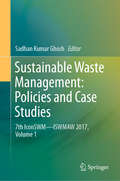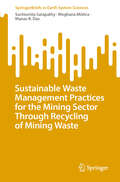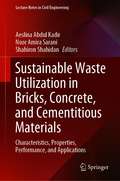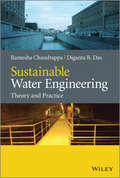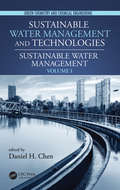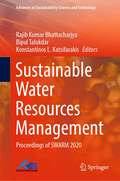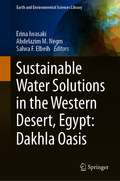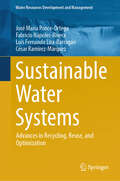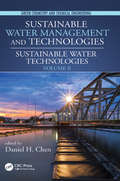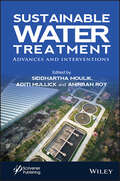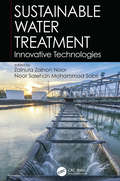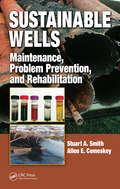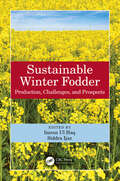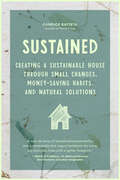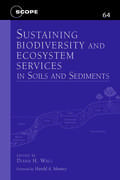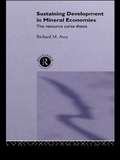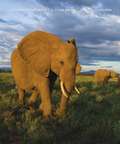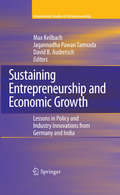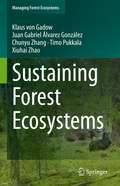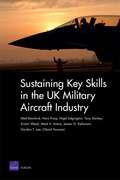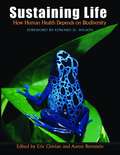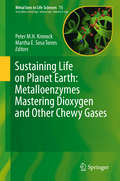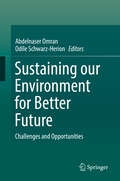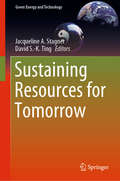- Table View
- List View
Sustainable Waste Management: 7th IconSWM—ISWMAW 2017, Volume 1
by Sadhan Kumar GhoshThe book presents high-quality research papers from the Seventh International Conference on Solid Waste Management (IconSWM 2017), held at Professor Jayashankar Telangana State Agricultural University, Hyderabad on December 15–17, 2017. The conference, an official side event of the high-level Intergovernmental Eighth Regional 3R Forum in Asia and the Pacific, aimed to generate scientific inputs into the policy consultation of the Forum co-organized by the UNCRD/UNDESA, MoEFCC India, MOUD India and MOEJ, Japan. Presenting research on solid waste management from more than 30 countries, the book is divided into three volumes and addresses various issues related to innovation and implementation in sustainable waste management, segregation, collection, transportation of waste, treatment technology, policy and strategies, energy recovery, life cycle analysis, climate change, research and business opportunities.
Sustainable Waste Management Practices for the Mining Sector Through Recycling of Mining Waste (SpringerBriefs in Earth System Sciences)
by Suchismita Satapathy Meghana Mishra Manas R. DasMining waste management is an important issue for the mining industry since it entails the safe and responsible disposal of waste created during mining operations. This waste comprises tailing, waste rock, and other mining wastes that, if not adequately managed, can pose environmental and health problems. Effective waste management solutions are required to reduce the environmental impact of mining and preserve the long-term viability of mining operations. These initiatives include improving mining practices to reduce waste generation, establishing effective waste treatment and disposal systems, and participating in community outreach and education programme. In recent years, there has been a growing emphasis on the use of new mining waste management technologies and practices. The adoption of modern filtration systems, bio-remediation techniques, and the rehabilitation of abandoned mining sites are examples of these. Overall, good mining waste management is critical for guaranteeing the mining industry; long-term sustainability and protecting the environment and communities where mining operations take place. Sustainable waste management is the implementation of practices and strategies that aim to minimize aim the negative impact of mining waste while promoting resource efficiency and long-term economic viability it involves employing a thorough approach that considers the entire mining waste lifetime, from generation to disposal, and seeks to reduce waste generation, reuse, or recycle items, and appropriately dispose of any remaining rubbish. It attempts to extend the life of materials while reducing the waste volume that is incinerated or dumped in landfills. To lessen the detrimental environmental, economic, social and effects in consumption, a thorough approach to sustainable waste management must concentrate on the life cycle of a product. Mining wastes can be categorized into overburden, waste rock, tailings and mine water. During mineral extracted, beneficiated, and processed, mining wastes are produced. The first stage, known as extraction, which is the first layer sacking of minerals. Typically, blasting is used to do this, which produces a significant amount of garbage (soil, debris and other material). This is usually only concentrated within the periphery of a mine rental place and occasionally on public land, and is useless to the industry. The amount of waste produced increases with the size of the mine. Because they produce far more trash than underground mines, opencast mines are consequently more pollutant-intensive. Use of tailing waste of iron mines with clay for producing bricks can lead to consumption of large quantities of the waste materials and managing it in an environmentally friendly way. On the other hand, it can reduce consumption of top soil for making bricks and improve construction materials availability. Similarly, for preparation of ceramics and polymer composite, these wastes can be used, which will help in solving social, environmental problem.
Sustainable Waste Utilization in Bricks, Concrete, and Cementitious Materials: Characteristics, Properties, Performance, and Applications (Lecture Notes in Civil Engineering #129)
by Aeslina Abdul Kadir Noor Amira Sarani Shahiron ShahidanThis book highlights the current research, conceptual and practical utilization of waste in building materials. It examines the production of industrial and agricultural wastes that have been generated worldwide and have significant environmental impact. The book discusses how to incorporate these wastes effectively with greener technology and how to address its environmental impact in order to produce environmentally friendly and sustainable green products. This book also will capitalize on its practical application, properties, performance and economic advantages. The topics covered include the physical, mechanical and environmental properties, leaching behaviour, gas emissions and performance of sustainable construction materials. This book offers a valuable reference for researchers, industries and interested stakeholders in sustainable construction or any allied fields.
Sustainable Water and Environmental Management in the California Bay-Delta
by Committee on Sustainable Water Environmental Management in the California Bay-DeltaExtensively modified over the last century and a half, California's San Francisco Bay Delta Estuary remains biologically diverse and functions as a central element in California's water supply system. Uncertainties about the future, actions taken under the federal Endangered Species Act (ESA) and companion California statues, and lawsuits have led to conflict concerning the timing and amount of water that can be diverted from the Delta for agriculture, municipal, and industrial purposes and concerning how much water is needed to protect the Delta ecosystem and its component species. Sustainable Water and Environmental Management in the California Bay-Delta focuses on scientific questions, assumptions, and conclusions underlying water-management alternatives and reviews the initial public draft of the Bay Delta Conservation Plan in terms of adequacy of its use of science and adaptive management. In addition, this report identifies the factors that may be contributing to the decline of federally listed species, recommend future water-supple and delivery options that reflect proper consideration of climate change and compatibility with objectives of maintaining a sustainable Bay-Delta ecosystem, advises what degree of restoration of the Delta system is likely to be attainable, and provides metrics that can be used by resource managers to measure progress toward restoration goals.
Sustainable Water Engineering
by Diganta B. Das Ramesha ChandrappaEnsuring safe and plentiful supplies of potable water (both now and for future generations) and developing sustainable treatment processes for wastewater are among the world's greatest engineering challenges. However, sustainability requires investment of money, time and knowledge. Some parts of the world are already working towards this goal but many nations have neither the political will nor the resources to tackle even basic provision and sanitation. Combining theory and practice from the developing and developed worlds with high- and low-tech, high- and low-cost solutions, this book discusses fundamental and advanced aspects of water engineering and includes: water resource issues including climate change, water scarcity, economic and financial aspects requirements for sustainable water systems fundamentals of treatment and process design industrial water use and wastewater treatment sustainable effluent disposal sustainable construction principles With integrated theory, design and operation specifications for each treatment process, this book addresses the extent to which various treatment methods work in theory as well as how cost effective they are in practice. It provides a nontechnical guide on how to recover and reuse water from effluent, which is suitable for those in water resource management, environmental planning, civil and chemical engineering.
Sustainable Water Management (Green Chemistry and Chemical Engineering)
by Daniel H. ChenWhile the world’s population continues to grow, the availability of water remains constant. Facing the looming water crisis, society needs to tackle strategic management issues as an integrated part of the solution toward water sustainability. The first volume in the two-volume set Sustainable Water Management and Technologies offers readers a practical and comprehensive look at such key water management topics as water resource planning and governance, water infrastructure planning and adaption, proper regulations, and water scarcity and inequality. It discusses best management practices for water resource allocation, ground water protection, and water quality assurance, especially for rural, arid, and underdeveloped regions of the world. Timely topics such as drought, ecosystem sustainability, climate change, and water management for shale oil and gas development are presented. Discusses best practices for water resource allocation, ground water protection, and water quality assurance. Offers chapters on urban, rural, arid, and underdeveloped regions of the world. Describes timely topics such as drought, ecosystem sustainability, climate change, and water management for shale oil and gas development. Covers water resource planning and governance, water infrastructure planning and adaptation, proper regulations, and water scarcity and inequality Discusses water resource monitoring, efficiency, and quality management.
Sustainable Water Resources Management: Proceedings of SWARM 2020 (Advances in Sustainability Science and Technology)
by Rajib Kumar Bhattacharjya Bipul Talukdar Konstantinos L. KatsifarakisThis book brings high-quality selected research articles from the international conference on Sustainable Water Resources Management (SWARM 2020), held at Assam Engineering College, Guwahati, Assam, India, during 19–21 June 2020. The book focuses on water management and planning, urban water management, climate change and global warming, management of groundwater and aquifer remediation, water conservation, water quality, pollution control, management of trans-boundary rivers, advanced hydrological modelling and hydro-disaster risk management of sustainable water management.
Sustainable Water Solutions in the Western Desert, Egypt: Dakhla Oasis (Earth and Environmental Sciences Library)
by Abdelazim M. Negm Salwa F. Elbeih Erina IwasakiThis book is a multidisciplinary manuscript bringing together contributions on water issues from natural and social scientists focused on water management and structures in a challenging environmental situation such as Dakhla Oasis in Egypt's western desert. The authors of this book are relevant scientists in hydrology, geology, remote sensing, agriculture, history, and sociology. It is devoted to various critical environmental topics such as geological and hydraulic structure, climate influence, underground water management, irrigation management, and human settlement. The book provides a range of new perspectives on solving different environmental problems in arid zones toward the region's sustainable development, based on the case studies and fieldwork in the Dakhla Oasis (Western Desert, Egypt).
Sustainable Water Systems: Advances in Recycling, Reuse, and Optimization (Water Resources Development and Management)
by José María Ponce-Ortega Fabricio Nápoles-Rivera Luis Fernando Lira-Barragán César Ramírez-MárquezThis book explores advanced recycling and optimization techniques, offering a blend of practical case studies and theoretical models that push the boundaries of traditional water management practices. Each chapter covers various aspects of sustainable water management, from the reuse of wastewater in residential complexes to the design of eco-industrial parks. By integrating environmental engineering, economics, and urban planning, the book addresses the pressing need for sustainable water solutions, presenting cutting-edge optimization models and economic analyses crucial for professionals and decision-makers. The incorporation of dynamic and strategic planning in the context of environmental constraints and uncertainties makes it an essential resource for navigating the complexities of modern water systems. Providing innovative strategies for a sustainable future, this book stands as a pivotal work in the field of water resource management.
Sustainable Water Technologies (Green Chemistry and Chemical Engineering)
by Daniel H. ChenDevelopment of advanced technologies is a critical component in overcoming the looming water crisis. Stressing emerging technologies and strategies that facilitate water sustainability for future generations, the second volume in the two-volume set Sustainable Water Management and Technologies provides current and forthcoming technologies research, development, and applications to help ensure availability of water for all. The book emphasizes emerging nanotechnology, biotechnology, and information technology applications as well as sustainable processes and products to protect the environment and human health, save water and energy, and minimize material use. It also discusses such topics as groundwater transport, protection, and remediation, industrial and wastewater treatment, reuse, and disposal, membrane technology for water purification and desalination, treatment and disposal in unconventional oil and gas development, biodegradation, and bioremediation for soil and water. Stresses emerging technologies and strategies that facilitate water sustainability. Covers a wide array of topics including drinking water, wastewater, and groundwater treatment, protection, and remediation. Discusses oil and gas drilling impacts and pollution prevention, membrane technology for water desalination and purification, biodegradation, and bioremediation for soil and water. Details emerging nanotechnology, biotechnology, and information technology applications, as well as sustainable processes and products.
Sustainable Water Treatment: Advances and Interventions
by Siddhartha Moulik Aditi Mullick Anirban RoySUSTAINABLE WATER TREATMENT This outstanding new volume is a compendium of reference material which will cover most of the relevant and state-of-art approaches in the field of water treatment, focusing on technological advances for water treatment in four categories: advanced oxidation technologies, nanoparticles for water treatment, membrane separations, and other emerging technologies or processes. Apart from this perspective, fundamental discussions on a wide variety of pollutants have also been included, such as acidic wastewater treatment, metallurgical wastewater, textile wastewater as well as groundwater. The editors have not only covered a wide range of water treatment techniques, but also focus on their applications, offering a holistic perspective on water treatment in general. Covering all of the latest advances, innovations, and developments in practical applications for sustainable water treatment, this volume represents the most comprehensive, up-to-date coverage of the issues of the day and state of the art. Whether for the veteran engineer or scientist or a student, this volume is a must-have for any library. Sustainable Water Treatment: Advances and Interventions covers: Provides an insight into various sectors of water and wastewater treatment technologies, introducing key technical topics Is a comprehensive guide to technological interventions for water and wastewater treatment Is also a reference book for any elective course on water treatment for engineers, scientists, and students, at both the undergraduate and graduate levels Presents the most current and up-to-date advances in sustainable water treatment Covers key technical topics and gives readers a comprehensive understanding of the latest research findings Includes perspectives on future trends and challenges
Sustainable Water Treatment: Innovative Technologies
by Zainura Zainon Noor and Noor Salehan Mohammad SabliThis book focuses on green and innovative wastewater treatment technologies that promote sustainability. It discusses a variety of biological, physical, and chemical treatment technologies. It covers biological processes for recovery of value-added products from wastewater and gives an overview of enzymatic hydrolysis and bioremediation of wastewater using immobilized enzyme and fungus. It offers a case study and future trends of wastewater treatment through membrane bioreactor technologies, describes advanced chemical–physical processes for recalcitrant pollutant, and emphasizes the use of low-cost materials and cost-effective treatment methods.
Sustainable Wells: Maintenance, Problem Prevention, and Rehabilitation
by Stuart A. Smith Allen E. ComeskeyNo one has recorded when well digging started, but surely humans imitated elephants in digging holes in the sand to access cooler water that didn't make the children sick. Eventually, humankind began to redesign, maintain, and repair the wells they constructed, but when wells became "commodities" in the twentieth century, this maintenance ethic was
Sustainable Winter Fodder: Production, Challenges, and Prospects
by Imran Ul Haq Siddra IjazForage crops are an essential component of livestock’s diet. Production and availability of sufficiently good quality forage under diverse ecological dynamics are fundamental to develop an efficient and productive livestock industry. Growers worldwide, especially in developing and underdeveloped countries, face significant challenges in producing sufficient winter fodder. The livestock population is increasing at high rates, and its feed requirement is increasing accordingly. Fodder crops are the leading and cheapest source of feed for livestock; however, the shortage of fodder production is the primary limiting factor for livestock production. This book features an extensive overview of literature providing information on winter fodders used in livestock management. Key features Discusses breeding strategies of winter fodders through conventional approaches and biotechnology. Highlights production, agronomy, and bioecology of winter fodder crops. Provides comprehensive information on the ecological dynamics of winter fodders. Describes the use of precision agriculture for mitigating the effect of climate change on winter fodders. Relays challenges of winter fodder crops on account of microbes, toxins, pests, and diseases. This book is written for researchers and practitioners in agronomy, biotechnology, bioecology and is a comprehensive guide for improving winter fodder production.
Sustained: Creating a Sustainable House Through Small Changes, Money-Saving Habits, and Natural Solutions
by Candice BatistaHelp Save Our Planet with Money-Saving Sustainable Tips for Your HouseHouseholds are among the biggest contributors to global greenhouse gas emissions worldwide. Could the secrets of saving the environment (and money) be closer to home than we thought?Looking for easy, budget-friendly ways to reduce your environmental impact and save money? Authored by award-winning environmental journalist, Candice Batista, Sustained takes you on an eye-opening journey towards sustainability and eco-friendly living─starting at home. This step-by-step, eco-living guide offers simple yet powerful ways to turn each room in your home into a hub of sustainability, while pocketing impressive savings every step of the way.Small changes, big impact. Starting with a deep dive into how our actions at home impact the planet, Sustained offers a practical suite of never-before-seen tools and solutions to initiate the shift towards a greener lifestyle–without draining your time, energy, or budget.Inside find:Eye-Opening Ideas: Explore green cleaning alternatives, ethical fashion brand recommendations, kitchen composting and waste management advice, laundry routine overhaul guidance, and more.Cleaner and Greener: Reduce your dependence on chemical products and single-use plastics, decipher cryptic food and fashion labels, shop like an eco-pro, and make room for a new lifestyle that’s kinder to you, your pocket, and the planet.Eco-Living Simplified: Going green doesn’t have to push your bank account into the red. Uncover tried-and-trusted tips for sustainable living, fresh recipe ideas, and up-to-date insights into top-rated biodegradable home products.Environmentally conscious readers of sustainability books like Simply Living Well, The Backyard Homestead Bible, or Sustainable Minimalism, will love Candice Batista's Sustained.
Sustaining Biodiversity and Ecosystem Services in Soils and Sediments (SCOPE Series #64)
by Diana H. WallSustaining Biodiversity and Ecosystem Services in Soils and Sediments brings together the world's leading ecologists, systematists, and evolutionary biologists to present scientific information that integrates soil and sediment disciplines across terrestrial, marine, and freshwater ecosystems. It offers a framework for a new discipline, one that will allow future scientists to consider the linkages of biodiversity below-surface, and how biota interact to provide the essential ecosystemservices needed for sustainable soils and sediments.Contributors consider key-questions regarding soils and sediments and the relationship between soil- and sediment- dwelling organisms and overall ecosystem functioning. The book is an important new synthesis for scientists and researchers studying a range of topics, including global sustainability, conservation biology, taxonomy, erosion, extreme systems, food production, and related fields. In addition, it provides new insight and understanding for managers, policymakers, and others concerned with global environmental sustainability and global change issues.
Sustaining Development in Mineral Economies: The Resource Curse Thesis
by Richard AutyIt is widely believed that natural mineral resources are desirable. However there is growing evidence that this may not always be the case. Indeed, it seems that natural assets can distort the economy to such a degree that the benefit actually becomes a curse. In Sustaining Development in Mineral Economies, Richard Auty highlights these drawbacks and the devastating effect they can have on developing economies. With reference to six ore-exporters (viz. Peru, Bolivia, Chile, Jamaica, Zambia and Papua New Guinea) he outlines how things can go badly wrong. He particularly stresses the need to avoid `Dutch Disease' whereby competitiveness is drained out of the agriculture and manufacturing sectors so that in the long term growth falters.
Sustaining The Earth
by G. Miller Scott SpoolmanSUSTAINING THE EARTH provides the basic scientific tools for understanding and thinking critically about the environmental problems we face. About half the price of other environmental science texts, this 14-chapter, one-color core book offers an integrated approach that emphasizes how environmental and resource problems and solutions are related. The new edition of SUSTAINING THE EARTH is fully updated with the latest statistics and reports of important scientific studies. New Connections boxes show surprising but important connections between environmental problems and aspects of daily life. In addition, new Thinking About boxes help students apply the concepts of the book to their own lives. Sustainability is the integrating theme of this current and thought-provoking book. The concept-centered approach transforms complex environmental topics and issues into key concepts that students will understand and remember. By framing the concepts with goals for more sustainable lifestyles and human communities, students see how promising the future can be.
Sustaining Entrepreneurship and Economic Growth
by Jagannadha Pawan Tamvada David B. Audretsch Max KeilbachAcademic research on developed countries has scientifically evaluated the role of entrepreneurship on economic growth, market expansion, commercializing innovation, and reducing unemployment. In this research, regions or industries with higher rates of entrepreneurship show higher levels of innovation and economic growth. The literature on entrepreneurship and innovation has largely ignored developing countries, despite the positive results from new venture investments in India, China, and elsewhere. This volume bridges this gap by bringing together research by scholars in Germany and India, whose analysis of entrepreneurship, innovation, and economic development in their respective countries reveals commonalities. Covering such timely issues as R&D and labor policies and including case examples from the chemical, biotech, and IT industries, the authors offer insight into the entrepreneurial process. The volume concludes with a discussion of the global implications for entrepreneurship research and policy.
Sustaining Forest Ecosystems (Managing Forest Ecosystems #37)
by Klaus von Gadow Juan Gabriel Álvarez González Chunyu Zhang Timo Pukkala Xiuhai ZhaoForest ecosystems include a great variety of communities of organisms interacting with their physical environment: multi-aged natural forests, even-aged monocultures, and secondary forests invaded by foreign species. The challenge is to sustain their ability to function, by adapting to changing climates and satisfying a multitude of human demands. Our first chapter sets the scene with a discussion about the effects of forest management on ecosystem services. Details about forest observational infrastructures are introduced in the second chapter. The third chapter presents methods of analysing forest density and structure. Models for estimating the shape and growth of individual forest trees are introduced in chapter 4, models of forest community production in Chapter 5. Methods and examples of sustainable forest design are covered in chapter 6. New scientific contributions continue to emerge as we are writing, and this work is never finished. We hope to continue with regular updates replacing obsolete sections with new ones, but the general aim remains the same, to introduce a range of methods that will assist those interested in sustaining forest ecosystems.
Sustaining Key Skills in the UK Military Aircraft Industry
by Tony Starkey Nigel Edgington Hans Pung Matt Bassford Kristin WeedThe United Kingdom Ministry of Defence's Fixed Wing Sector Strategy Board commissioned RAND Europe to assist in the development of a strategy and sustainment plan for the military fixed wing sector. RAND focused on the health and sustainment of key skills in the sector's industrial base. This monograph describes the qualitative and quantitative methodologies that the RAND team followed and summarises its findings and recommendations.
Sustaining Life: How Human Health Depends On Biodiversity
by Eric Chivian Aaron Bernstein Edward Wilson Kofi AnnanThe Earth's biodiversity-the rich variety of life on our planet-is disappearing at an alarming rate. And while many books have focused on the expected ecological consequences, or on the aesthetic, ethical, sociological, or economic dimensions of this loss, Sustaining Life is the first book to examine the full range of potential threats that diminishing biodiversity poses to human health. <p><p> Edited and written by Harvard Medical School physicians Eric Chivian and Aaron Bernstein, along with more than 100 leading scientists who contributed to writing and reviewing the book, Sustaining Life presents a comprehensive--and sobering--view of how human medicines, biomedical research, the emergence and spread of infectious diseases, and the production of food, both on land and in the oceans, depend on biodiversity. The book's ten chapters cover everything from what biodiversity is and how human activity threatens it to how we as individuals can help conserve the world's richly varied biota. Seven groups of organisms, some of the most endangered on Earth, provide detailed case studies to illustrate the contributions they have already made to human medicine, and those they are expected to make if we do not drive them to extinction. Drawing on the latest research, but written in language a general reader can easily follow, Sustaining Life argues that we can no longer see ourselves as separate from the natural world, nor assume that we will not be harmed by its alteration. Our health, as the authors so vividly show, depends on the health of other species and on the vitality of natural ecosystems. <p> With a foreword by E.O. Wilson and a prologue by Kofi Annan, and more than 200 poignant color illustrations, Sustaining Life contributes essential perspective to the debate over how humans affect biodiversity and a compelling demonstration of the human health costs. It is the winner of the Gerald L. Young Book Award in Human Ecology Best Sci-Tech Books of 2008 for Biology by Gregg Sapp of Library Journal
Sustaining Life on Planet Earth: Metalloenzymes Mastering Dioxygen and Other Chewy Gases
by Peter M. H. Kroneck Martha E. Sosa TorresMILS-15 provides an up-to-date review of the metalloenzymes involved in the activation, production, and conversion of molecular oxygen as well as the functionalization of the chemically inert gases methane and ammonia. Found either in aerobes (humans, animals, plants, microorganisms) or in anaerobes (so-called "impossible bacteria") these enzymes employ preferentially iron and copper at their active sites, in order to conserve energy by redox-driven proton pumps, to convert methane to methanol, or ammonia to hydroxylamine or other compounds. When it comes to the light-driven production of molecular oxygen, the tetranuclear manganese cluster of photosystem II must be regarded as the key player. However, dioxygen can also be produced in the dark, by heme iron-dependent dismutation of oxyanions. Metalloenzymes Mastering Dioxygen and Other Chewy Gasesis a vibrant research area based mainly on structural and microbial biology, inorganic biological chemistry, and environmental biochemistry. All this is covered in an authoritative manner in 7 stimulating chapters, written by 21 internationally recognized experts, and supported by nearly 1100 references, informative tables, and over 140 illustrations (many in color). MILS-15 provides excellent information for teaching; it is also closely related to MILS-14, The Metal-Driven Biogeochemistry of Gaseous Compounds in the Environment. Peter M. H. Kroneck is a bioinorganic chemist who is exploring the role of transition metals in biology, with a focus on functional and structural aspects of microbial iron, copper, and molybdenum enzymes and their impact on the biogeochemical cyles of nitrogen and sulfur. Martha E. Sosa Torres is an inorganic chemist, with special interests in magnetic properties of newly synthesized transition metal complexes and their reactivity towards molecular oxygen, applying kinetic, electrochemical, and spectroscopic techniques.
Sustaining our Environment for Better Future: Challenges and Opportunities
by Abdelnaser Omran Odile Schwarz-HerionThis book covers a variety of topics regarding environmental practices in our day-to-day lives, as well as topics concerning sustainable development as a broader concept embracing ecological, social, and economic aspects to improve the quality of life for people around the world. Starting with the traditional controversy between the neoclassical economy and sustainable economy, which may be overcome by scientific progress due to more intensive scientific studies of the sustainability paradigm, the book proceeds to discuss various problems and challenges regarding environmental protection and sustainable development in different countries and on different continents. This includes analyses of recent, sometimes fatal mining disasters in South and North America, challenges and opportunities for rural development in Africa and Australia, an exploration of the role of women for sustainable development in Palestine, water safety and water security issues in Asia and Australia, the environmental exploitation of popular tourism destinations like Acapulco, and deforestation in Malaysia, suggesting innovative approaches to turn challenges into opportunities to effectively tackle these problems. Other topics addressed involve sustainable energy creation for future generations, a research survey among Romanian students on sustainable consumption behavior, validity testing for a heat transfer model in a greenhouse, and a case study on sustainability risk management practices at Malaysia’s environmentally sensitive companies. The book closes with an examination of highly digitalized Smart Cities as a potentially valuable complement to conventional urban and rural lifestyles in connection with achieving the UN Sustainable Development Goals (SDGs).
Sustaining Resources for Tomorrow (Green Energy and Technology)
by Jacqueline A. Stagner David S.-K. TingThis book reflects the current state of knowledge on sustainability in a wide range of fields, from engineering to agriculture, to education. Though primarily intended to offer an update for experts and researchers in the field, it can also be used as a valuable educational tool for relevant undergraduate and graduate courses. Key aspects covered include the better and more responsible engineering and management of energy conversion processes, the development of renewable energy technologies, and improvements in conventional energy utilization and food production. In addition, the book addresses green buildings, the green economy, waste and recycling, water, ecopolitics and social sustainability.
